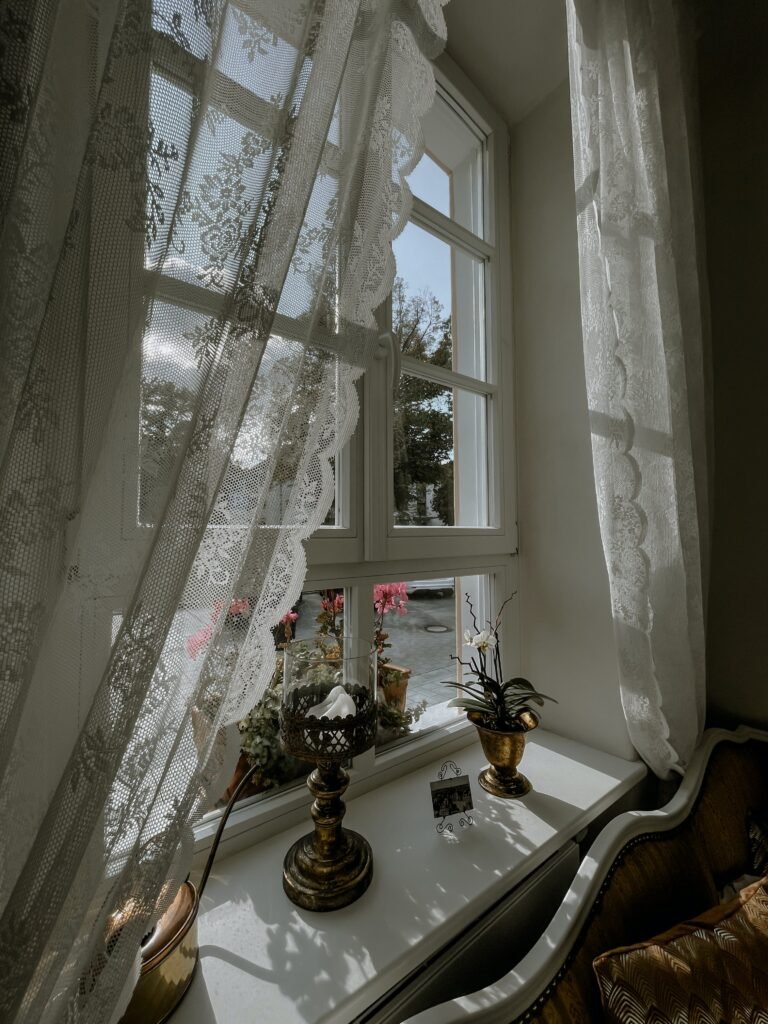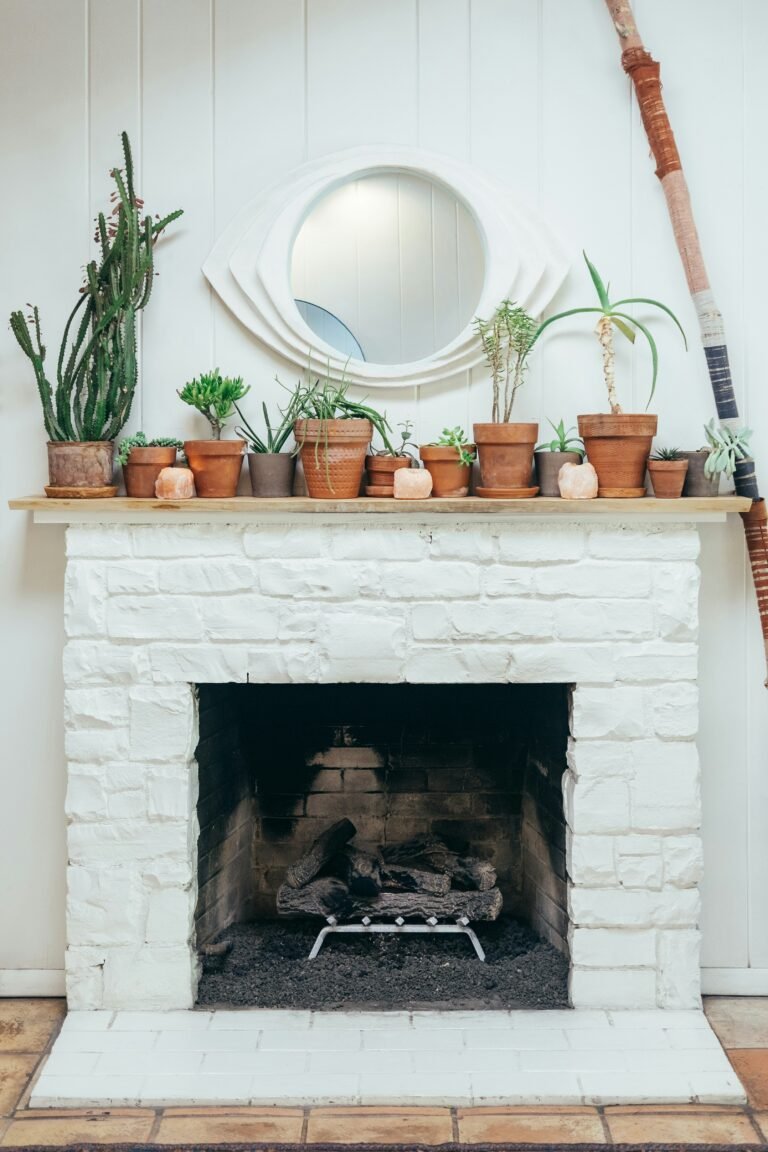Imagine transforming your dull and outdated fireplace into a stunning centerpiece of warmth and charm. In this article, you will discover 10 incredible DIY fireplace makeover ideas that will inspire you to unleash your creativity and bring a touch of coziness to your home. From modern and sleek designs to rustic and traditional styles, these ideas will help you breathe new life into your fireplace and create a focal point that will leave your guests in awe. Get ready to embark on a fun and rewarding DIY project that will transform your space and make your fireplace the heart of your home.

This image is property of images.pexels.com.
Painted Brick Fireplace Makeover
Strip the existing paint or wallpaper
To start your painted brick fireplace makeover, you will first need to strip any existing paint or wallpaper from the surface. This can be done using a paint stripper or wallpaper removal solution, following the manufacturer’s instructions. Make sure to protect the surrounding area with drop cloths or plastic sheeting.
Clean the brick surface thoroughly
Once the paint or wallpaper is removed, it’s essential to thoroughly clean the brick surface. Use a stiff brush and a mixture of warm water and mild soap to scrub away any dirt, grime, or residue. Pay attention to the crevices and mortar joints, ensuring that they are free from debris.
Choose the perfect paint color
Now comes the fun part – choosing the perfect paint color for your brick fireplace. Consider the overall color scheme of the room and your personal style preferences. Opt for a paint color that complements the room’s decor and creates the desired ambiance. Popular choices include neutral shades like white, gray, or beige, which can give a timeless and sophisticated look.
Apply a primer coat
Before applying the paint, it’s essential to apply a primer coat to the brick surface. This will provide a smooth and even base for the paint to adhere to. Choose a high-quality primer designed for masonry surfaces and follow the application instructions. Allow the primer to dry completely before moving on to the next step.
Paint the bricks using a brush or roller
Now it’s time to paint the bricks! Use a brush or roller to apply the paint evenly to the brick surface. Start from the top and work your way down, ensuring full coverage and paying attention to any crevices or mortar joints. Apply multiple coats if needed, allowing each coat to dry before applying the next. This will help achieve a more professional and polished look.
Create a whitewash effect with diluted paint
If you prefer a more rustic or shabby-chic look, consider creating a whitewash effect with diluted paint. Mix a small amount of paint with water to achieve the desired consistency and transparency. Then, using a brush or rag, apply the diluted paint to the brick surface, allowing some of the original brick texture to show through. This technique can add depth and character to your fireplace.
Add a stencil or pattern for a unique touch
For those who want to take their painted brick fireplace to the next level, consider adding a stencil or pattern for a unique touch. You can find various stencil designs at craft stores or create your own using cardboard or acetate sheets. Choose a contrasting paint color and carefully apply the stencil design to select areas of the brick surface. This will create a visually stunning focal point and showcase your creativity.
Tile Transformation
Remove the existing tiles
If you have a tiled fireplace that you wish to transform, the first step is to remove the existing tiles. This can be done by carefully prying them off using a putty knife or chisel. Be cautious not to damage the underlying surface.
Clean and prepare the fireplace surface
Once the tiles are removed, clean the fireplace surface thoroughly to ensure proper adhesion of the new tiles. Use a mixture of warm water and mild soap to remove any dirt, grime, or adhesive residue. Allow the surface to dry completely before proceeding.
Choose the right tile material and design
Choosing the right tile material and design is crucial to achieving the desired look for your fireplace. Consider factors such as the room’s style, maintenance requirements, and personal preference. Options range from classic ceramic or porcelain tiles to natural stone or even glass tiles. Select a design that complements the overall aesthetic of the space.
Measure and cut the tiles to size
Before applying the tiles, measure the fireplace surface and make precise cuts to ensure a perfect fit. Use a tile cutter or wet saw to cut the tiles as needed. Take your time and double-check the measurements to minimize any errors.
Apply adhesive and lay the tiles
Once the tiles are cut and ready, apply tile adhesive to the back of each tile using a trowel or a notched trowel. Press the tiles firmly onto the prepared fireplace surface, making sure they are level and evenly spaced. Use tile spacers if necessary to maintain consistent grout lines.
Grout the tiles for a finished look
After the adhesive has fully cured, it’s time to grout the tiles. Choose a grout color that complements your tile and fireplace design. Using a grout float or a rubber grout float, apply the grout to the tile joints, making sure to fill them completely. Remove any excess grout with a damp sponge, gently wiping diagonally across the tiles. Allow the grout to dry according to the manufacturer’s instructions.
Consider mosaic or patterned tiles for added interest
To add visual interest to your tile transformation, consider using mosaic or patterned tiles. Mosaic tiles come in different shapes and sizes, allowing you to create intricate designs or eye-catching patterns. Patterned tiles, on the other hand, offer unique and artistic visuals that can elevate the overall look of your fireplace. Mix and match different tiles to create a truly one-of-a-kind masterpiece.
Stunning Stone Veneer
Select the desired stone veneer type
Stone veneer is a great option for transforming your fireplace into a stunning focal point. Start by selecting the desired stone veneer type that suits your style and complements the room’s decor. Options include natural stone veneer, which offers an authentic and organic look, or manufactured stone veneer, which provides a more cost-effective and consistent appearance.
Prepare the fireplace surface
Before applying the stone veneer, it’s essential to prepare the fireplace surface. Clean it thoroughly to remove any dirt, dust, or loose materials. Ensure that the surface is smooth and free from any protrusions that could interfere with the veneer application.
Apply mortar to adhere the stone
To adhere the stone veneer, use a high-quality mortar designed specifically for stone applications. Apply a thin layer of mortar to the prepared fireplace surface using a trowel, ensuring an even coverage. The mortar acts as the glue that holds the stone veneer in place, so make sure to apply it generously.
Arrange and install the stone veneer pieces
Now comes the fun part – arranging and installing the stone veneer pieces. Place the stones on the fireplace surface, starting from the bottom and working your way up. Make sure to leave small gaps between the stones to replicate the look of natural stone. Adjust the position of the stones as needed to create a visually pleasing pattern or arrangement.
Fill in the gaps with mortar or grout
Once the stone veneer is in place, fill in the gaps between the stones with mortar or grout. Use a pointing trowel or a grout bag to ensure the spaces are completely filled. Smooth the mortar or grout using a jointing tool or a small brush, removing any excess material. This step helps create a cohesive and finished look.
Seal the stone veneer for protection and shine
To protect the stone veneer and enhance its natural beauty, it’s recommended to seal it with a stone sealer. This will help repel stains and moisture, allowing your fireplace to maintain its pristine appearance. Follow the manufacturer’s instructions for applying the sealer, and make sure to reapply it periodically for long-lasting protection.
Consider a stacked stone or brick veneer for a rustic look
If you’re aiming for a rustic or traditional look, consider using stacked stone or brick veneer for your fireplace makeover. Stacked stone veneer mimics the appearance of natural stone, with its irregular shapes and textures. On the other hand, brick veneer provides a timeless and classic aesthetic. Both options add warmth, character, and charm to any space.
Sleek Concrete Fireplace
Remove any existing material from the fireplace
Before starting a sleek concrete fireplace makeover, you need to remove any existing material from the fireplace surface. This may include paint, tiles, or other finishes. Use appropriate tools such as a scraper or chisel to carefully remove the material, taking care not to damage the underlying structure.
Build a concrete form using wood or metal
To create a sleek concrete fireplace, you will need to build a concrete form using wood or metal. The form will act as a mold and provide support for the poured concrete. Measure and cut the form pieces to match the dimensions of your fireplace, ensuring a snug fit.
Mix concrete and pour into the form
Next, mix the concrete according to the manufacturer’s instructions. Use a wheelbarrow or large bucket to mix the concrete thoroughly, ensuring a smooth and consistent texture. Pour the mixed concrete into the form, starting from the bottom and working your way up. Ensure that the concrete is evenly distributed within the form and fills all the necessary areas.
Smooth the surface with a trowel or float
Once the concrete is poured, use a trowel or float to smooth the surface. Gently glide the trowel or float over the concrete, removing any air bubbles or imperfections. Pay attention to achieving a level and even surface for a sleek and professional finish.
Add texture or patterns with stamps or stencils
To add visual interest to your concrete fireplace, consider adding texture or patterns using stamps or stencils. Stamps can create the appearance of natural stone, while stencils allow you to incorporate unique designs or motifs. Press the stamps or apply the stencils to the concrete while it is still wet, following the manufacturer’s instructions.
Cure the concrete for several days
After the concrete is poured and textured, it’s important to allow it to cure for several days. Curing allows the concrete to harden and strengthen, improving its durability and longevity. Follow the recommended curing time specified by the manufacturer, ensuring that the concrete is protected from excessive moisture or extreme temperatures during this period.
Seal the concrete for durability and aesthetics
To protect the concrete and enhance its appearance, it’s essential to seal the surface. Choose a concrete sealer that is suitable for indoor applications and follow the manufacturer’s instructions for application. Applying a sealer will help prevent stains, moisture absorption, and surface damage, ensuring that your sleek concrete fireplace stands the test of time.

This image is property of images.pexels.com.
Reclaimed Wood Magic
Find and prepare reclaimed wood planks
Reclaimed wood can bring a unique and charming element to your fireplace makeover. Start by sourcing reclaimed wood planks from salvage yards, demolition sites, or specialty retailers. Once you have the wood, thoroughly clean it to remove any dirt, nails, or other debris. Sand the surface if necessary to create a smooth and uniform look.
Measure and cut the wood to fit the fireplace
Measure the dimensions of your fireplace and carefully cut the reclaimed wood planks to fit. Use a miter saw or a circular saw to make precise cuts, ensuring that each piece aligns perfectly with the fireplace’s edges. Take your time and double-check the measurements to achieve a seamless and professional-looking finish.
Attach the wood using adhesive or nails
To attach the reclaimed wood planks to the fireplace, you can either use adhesive or nails. If using adhesive, choose a heavy-duty construction adhesive designed for wood-to-masonry applications. Apply the adhesive to the back of each wood plank and press it firmly onto the prepared fireplace surface. Alternatively, you can use nails or screws to secure the wood planks in place. This method provides a more rustic and visible fastening technique.
Sand and finish the wood for a polished look
After the wood planks are attached, it’s time to sand and finish the surface for a polished look. Use a medium-grit sandpaper or a sanding block to smooth out any rough edges, splinters, or imperfections. Follow up with a finer-grit sandpaper for a silky smooth finish. Once the sanding is complete, apply a wood finish or stain to enhance the wood’s natural beauty and protect it from moisture or wear.
Consider a herringbone or chevron pattern
To elevate the reclaimed wood fireplace makeover, consider arranging the wood planks in a herringbone or chevron pattern. These patterns add visual interest and create a sense of movement and depth. Lay the wood planks at an angle, alternating the direction to achieve the desired pattern. Take your time and ensure that each plank is securely fastened for a professional and sophisticated result.
Accentuate the grain with a stain or sealant
To highlight the beauty and richness of the reclaimed wood, consider using a stain or sealant that accentuates the natural grain. Apply the stain following the manufacturer’s instructions, using a brush or cloth. Wipe off any excess stain to achieve the desired color intensity. If you prefer a more natural look, opt for a clear sealant that enhances the wood’s appearance without adding color.
Add a mantel or shelf for additional functionality
To maximize the functionality of your reclaimed wood fireplace, consider adding a mantel or shelf. A mantel provides a platform for displaying artwork, family photos, or decorative objects, while a shelf offers space for storing books, candles, or other items. Choose a reclaimed wood mantel or shelf that complements the overall fireplace design and consider adding decorative brackets or corbels for added style.
Vintage Mantel Revamp
Source a vintage mantel or find a salvaged piece
To revamp your fireplace with a vintage touch, start by sourcing a vintage mantel or look for salvaged pieces at antique stores, architectural salvage yards, or online marketplaces. Look for a mantel that matches the style and scale of your fireplace, ensuring that it fits seamlessly within the overall space.
Clean and restore the mantel’s original beauty
Once you have your vintage mantel, it’s time to clean and restore its original beauty. Use a gentle soap and warm water to remove any dirt, dust, or grime. Avoid using harsh cleaning agents that could damage the wood or finish. If the mantel has any imperfections or scratches, consider refinishing or repairing it to bring back its former glory.
Repaint or refinish the mantel for a fresh look
To give your vintage mantel a fresh and updated look, consider repainting or refinishing it. Choose a paint color or stain that complements your room’s decor and personal style. If you want to maintain the vintage charm, opt for a distressed or aged finish that adds character and authenticity to the piece. Apply the paint or stain according to the manufacturer’s instructions, allowing sufficient drying time between coats.
Replace or update the mantel hardware
To complete the vintage mantel revamp, replace or update the hardware. Consider decorative knobs, pulls, or hinges that match the style and era of the mantel. Brass, bronze, or antiqued finishes can enhance the vintage aesthetic. Ensure that the hardware is securely attached and functions properly for convenience and longevity.
Consider adding decorative molding or trim
For an extra touch of elegance and sophistication, consider adding decorative molding or trim to the vintage mantel. Crown molding, trim, or corbels can enhance the architectural details and create a focal point in your space. Choose a design that complements the style of your room and the mantel itself. Install the molding or trim carefully, ensuring precise measurements and smooth transitions.
Pair the mantel with complementary decor
To highlight the beauty of your vintage mantel, pair it with complementary decor that enhances its charm. Display artwork, photographs, or mirrors above the mantel to create a focal point. Add decorative objects such as candles, vases, or figurines that reflect the mantel’s style and era. Consider incorporating elements from the same time period to create a cohesive and visually pleasing arrangement.
Create a focal point with artwork or a mirror
To further enhance the impact of your vintage mantel, create a focal point with artwork or a mirror. Choose a large, statement piece that complements the style and colors of the mantel. A carefully selected painting, photograph, or mirror can draw attention and add depth to your fireplace. Ensure that the artwork or mirror is securely hung and centered above the mantel for maximum visual impact.

This image is property of images.pexels.com.
Metallic Marvels
Clean and prepare the fireplace surface
To begin your metallic marvel fireplace makeover, clean and prepare the fireplace surface. Remove any existing dirt, dust, or grime using a soft cloth or a mild cleaning solution. Make sure the surface is dry and smooth before proceeding with the paint application.
Choose a metallic paint or finish
The key to achieving a metallic marvel fireplace is choosing the right metallic paint or finish. Consider the overall style of your room and the desired level of shine or sparkle. There are various metallic options available, from silver and gold to bronze and copper. Select a paint or finish that complements your room’s color scheme and creates the desired effect.
Apply a base coat of paint
Before applying the metallic paint or finish, it’s important to apply a base coat. This will provide a solid foundation for the metallic effect and help the color of the metallic paint to pop. Choose a base coat color that harmonizes with the metallic shade you’ve chosen. Apply the base coat evenly using a roller or brush, and allow it to dry completely.
Create a faux metal effect with glazes and layers
To create a more realistic faux metal effect, consider using glazes and layers. Apply a layer of metallic paint to the base coat, focusing on achieving a smooth and even application. Once dry, use a glaze or metallic wax in a contrasting shade to add depth and dimension. Apply it lightly, blending it in with a soft cloth or brush for a subtle yet striking effect.
Use a sponge or brush to apply the metallic paint
When applying the metallic paint, consider using a sponge or brush instead of a traditional roller. This will allow you to create interesting textures and patterns, enhancing the overall metallic look. Dab the sponge or brush gently onto the surface, building up the metallic color gradually. Experiment with different application techniques to achieve the desired effect.
Add accents or details with metallic spray paint
To add extra accents or details to your metallic marvel fireplace, consider using metallic spray paint. Choose a metallic spray paint in a contrasting shade or even a complementary color. Use stencils or freehand techniques to apply the spray paint strategically, adding interesting designs or patterns. This will create a visually stunning and personalized touch.
Seal the finish for longevity and shine
To protect the metallic finish and enhance its longevity and shine, it’s important to seal the surface. Choose a clear sealant designed for metallic finishes and follow the manufacturer’s instructions for application. Applying a sealant will protect the finish from scratches, chipping, or fading, ensuring that your metallic marvel fireplace looks stunning for years to come.
Modernized Marble
Clean and measure the fireplace surround
To modernize your fireplace with marble, start by cleaning the fireplace surround thoroughly. Remove any dirt, dust, or residue using a soft cloth or a mild cleaning solution. Ensure that the surface is dry and free from any debris before proceeding. Once cleaned, measure the fireplace surround to determine the amount of marble needed.
Choose the desired marble slab or tile
When it comes to choosing the desired marble for your fireplace, the options are vast. Marble is available in various colors, patterns, and textures, each offering a unique and sophisticated look. Consider the overall style of your room and the desired level of elegance. Whether you prefer classic white Carrara marble or more dramatic black or green marble, make sure to select a slab or tile that complements your space.
Cut the marble to fit the fireplace dimensions
To ensure a perfect fit, cut the marble slab or tile to fit the dimensions of your fireplace surround. Use a wet saw or a diamond blade to make precise cuts, following the measurements you gathered earlier. Take your time and work carefully, as marble is a delicate material that can chip or crack if not handled properly.
Apply marble adhesive or silicone on the back
To adhere the marble to the fireplace surround, apply a marble adhesive or silicone on the back of each slab or tile. Use a notched trowel or a caulk gun to apply the adhesive evenly, ensuring full coverage. Spread the adhesive or silicone in a consistent thickness to achieve a secure bond between the marble and the surface.
Position and press the marble onto the fireplace
Once the adhesive or silicone is applied, carefully position the marble slab or tile onto the fireplace surround. Press it firmly and evenly, ensuring that it adheres securely to the surface. Take care not to slide or shift the marble, as this can cause the adhesive to spread unevenly or lead to misalignment.
Secure the marble with clamps or weights
To ensure a strong and secure bond, use clamps or weights to hold the marble in place. This will prevent any shifting or movement while the adhesive or silicone cures. Follow the manufacturer’s instructions for the recommended amount of time needed for the adhesive or silicone to set. Once cured, remove the clamps or weights and check that the marble is firmly attached.
Seal the marble to protect against stains
To protect your modernized marble fireplace from stains and discoloration, it’s important to seal the surface. Apply a marble sealer following the manufacturer’s instructions, making sure to cover the entire surface evenly. Sealing the marble will create a protective barrier against liquids, ensuring its longevity and maintaining its pristine appearance over time. Remember to periodically reapply the sealer to maintain its effectiveness.
Creative Wallpaper Update
Remove any existing wallpaper or paint
If your fireplace is currently covered with wallpaper or paint, the first step to a creative wallpaper update is to remove the existing layer. Use a wallpaper steamer or a wallpaper stripping solution to soften the adhesive and gently peel away the wallpaper. If there is paint on the surface, consider using a paint scraper or sandpaper to remove the paint, ensuring a smooth and clean surface.
Choose a wallpaper pattern or design
Now comes the fun part – choosing a wallpaper pattern or design that suits your style and complements your room’s decor. There are countless options available, from bold and vibrant patterns to subtle and understated designs. Consider the overall color scheme, texture, and theme of your space, ensuring that the selected wallpaper enhances the ambiance and creates a visually stunning effect.
Prepare the fireplace surface
Once you have chosen your desired wallpaper, it’s important to prepare the surface before applying it. Clean the fireplace surface thoroughly to remove any dust, dirt, or residue that could affect adhesion. Use a mild cleaning solution and a soft cloth or sponge, ensuring that the surface is dry before proceeding. Repair any imperfections or damages, such as cracks or holes, to ensure a smooth and uniform application of the wallpaper.
Apply wallpaper adhesive using a brush or roller
To apply the wallpaper, use a wallpaper adhesive specifically designed for your chosen wallpaper material. Read the manufacturer’s instructions carefully and mix the adhesive accordingly. Apply the adhesive to the back of the wallpaper using a brush or roller, ensuring even coverage. Take care not to apply too much adhesive, as this can cause the wallpaper to become too wet or prone to bubbles.
Carefully place and smooth the wallpaper onto the surface
Once the adhesive is applied, carefully place the wallpaper onto the prepared fireplace surface. Start at the top and slowly work your way down, smoothing the wallpaper as you go. Use a wallpaper brush or a smoothing tool to eliminate any air bubbles or wrinkles. Take your time and work methodically to achieve a seamless and professional finish.
Trim excess wallpaper with a sharp blade
Once the wallpaper is applied and smoothed, trim any excess material using a sharp blade or a utility knife. Carefully cut along the edges of the fireplace, ensuring a clean and precise cut. Take caution not to scratch or damage the wallpaper or the fireplace surface. Remove any trimmed pieces of wallpaper and gently wipe away any adhesive residue.
Consider a removable or temporary wallpaper for flexibility
If you prefer flexibility and the option to change your fireplace’s look in the future, consider using removable or temporary wallpaper. These types of wallpaper are designed to be easily removed without damaging the surface or leaving any adhesive residue. Removable wallpaper allows you to experiment with different patterns, colors, and designs, providing the freedom to update your fireplace whenever inspiration strikes.
Dramatic Built-In Bookcase
Plan and measure for the built-in bookcase
To create a dramatic built-in bookcase around your fireplace, start by planning and measuring the space. Consider the height, width, and depth of the bookcase, ensuring that it fits proportionally within the room. Determine the desired number of shelves and the spacing between them. Take into account any existing architectural features, such as windows or doors, that may affect the design.
Remove any existing materials from the fireplace
Before building the bookcase, remove any existing materials from the fireplace area. This may include tiles, mantels, or other elements that obstruct the desired bookcase design. Carefully remove these materials, taking care not to damage the underlying structure or create additional repairs. Clean the area thoroughly to create a clean canvas for the bookcase construction.
Build the bookcase frame with wood or other materials
Once the fireplace area is cleared, it’s time to build the bookcase frame. Use sturdy and durable materials such as wood or MDF (medium-density fiberboard) to construct the frame. Start with the vertical supports, securing them to the floor, ceiling, and adjacent walls, ensuring they are plumb and level. Install horizontal supports to create the shelves and connect the vertical supports for added stability.
Install shelves and secure them in place
After the bookcase frame is constructed, install the shelves. Cut the shelves to the desired width and depth, ensuring an exact fit within the frame. Secure the shelves in place using screws or nails, making sure they are level and sturdy. Consider reinforcing the shelves with additional supports if needed, depending on their length and weight capacity.
Paint or stain the bookcase to match the room decor
Once the bookcase is fully constructed, it’s time to paint or stain it to match the room’s decor. Choose a paint color or stain that complements the existing color scheme or create a contrasting effect. Apply the paint or stain evenly using a brush or roller, allowing sufficient drying time between coats. Consider adding a clear sealant to protect the finish and enhance its longevity.
Add decorative trim or molding for a finished look
To elevate the visual impact of the built-in bookcase, consider adding decorative trim or molding. Choose a design that complements the style of your room, whether it be traditional, modern, or rustic. Install the trim or molding along the edges of the bookcase, creating a finished and polished look. Take care to miter the corners and nail or glue the trim securely in place.
Style the bookcase with books, accessories, and artwork
To complete the dramatic built-in bookcase, style it with books, accessories, and artwork. Arrange books of various sizes and colors on the shelves, creating an aesthetically pleasing display. Add decorative objects such as vases, picture frames, or sculptures to add depth and interest. Consider incorporating artwork or mirrors on the back of the bookcase for a visually striking effect. Experiment with different arrangements until you achieve a balanced and visually pleasing result.
In conclusion, these DIY fireplace makeover ideas offer a wide range of options to transform your fireplace into a stunning centerpiece. Whether you prefer a painted brick, tiled, stone veneer, concrete, reclaimed wood, vintage mantel, metallic, marble, wallpaper, or built-in bookcase look, there is a creative solution for every style and preference. By following the outlined steps and expanding on each section, you can successfully revamp your fireplace and add a touch of personality and coziness to your living space. So grab your tools, unleash your creativity, and embark on an exciting fireplace makeover journey!




